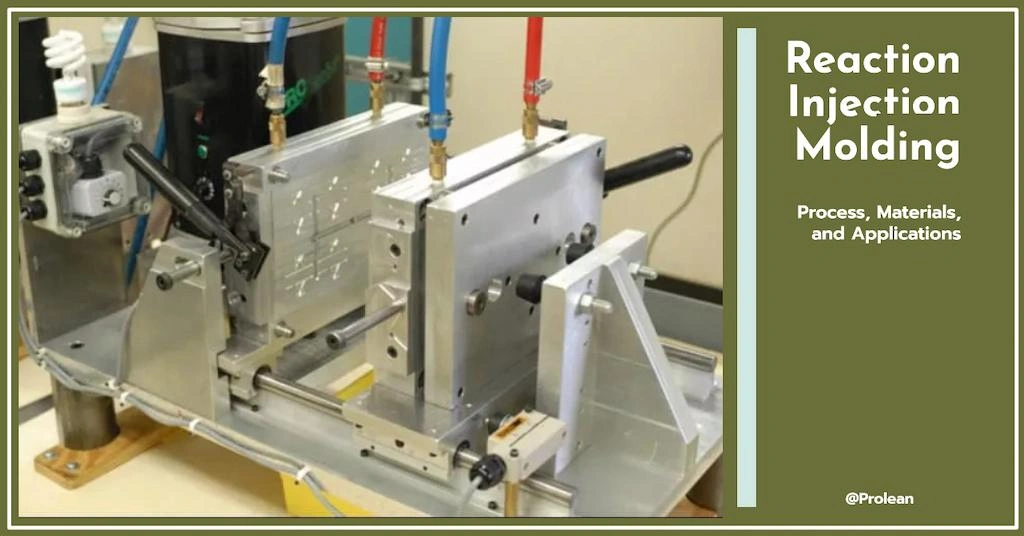
Especially for plastic parts, injection molding is a key manufacturing technique. Its capability of producing consistent parts in large volumes makes it a popular choice for industrial applications. What is Injection Molding? It is a process of creating parts by injecting the molten form of the material into the die; after that, die cooling solidifies it into the shape of the die cavity. Meanwhile, injection plastic molding variations like reaction molding make it a more specialized technique for diverse production needs.
The reaction injection molding process does not involve high-pressure injection. Instead, a tank stores the liquid polyol, and another tank contains isocyanate. Then, a mix of these two raw materials is passed into a die with controlled temperature and pressure, resulting in a lightweight and durable part upon solidification. This molding method is popular in automotive, medical, and industrial uses.
By the end of the article, we will discuss what reaction injection molding is. Its process, advantages, applications, and more.
What is Reaction Injection Molding(RIM)?
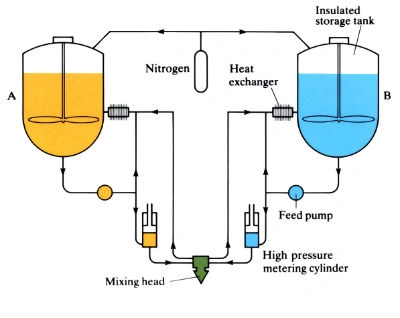
Reaction injection molding process
RIM molding is a low-pressure plastic molding process. It uses two storage tanks, where low-viscosity polymers are stored. Then, the mix of two polymer liquids is transferred into a mold with pre-determined cavity shapes using a pressurized pump. The mixing of two polymers inside the injection mold causes a chemical reaction that generates heat and builds a thicker component.
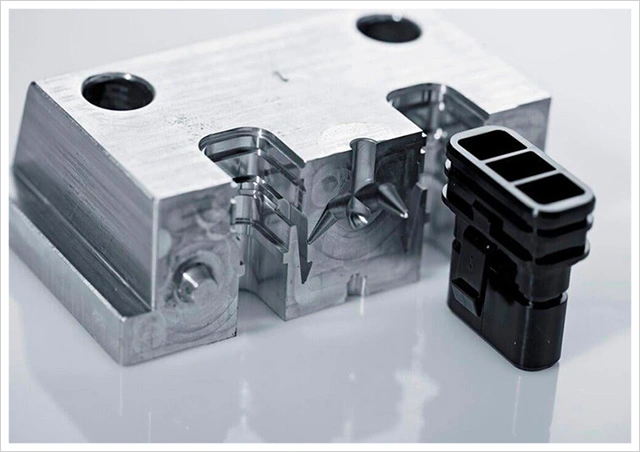
Reaction injection mold and part
The mixing of polymer liquids is critical for the quality of the final parts. Therefore, the mixing chamber operates at high pressure. Meanwhile, some additives like fiber reinforcements are added depending on the structural requirements. Furthermore, the low injection pressure ( 0.5–10 MPa) helps with foaming while solidifying.
Try Prolean Now!
How RIM Molding Differs from Standard Injection Molding?
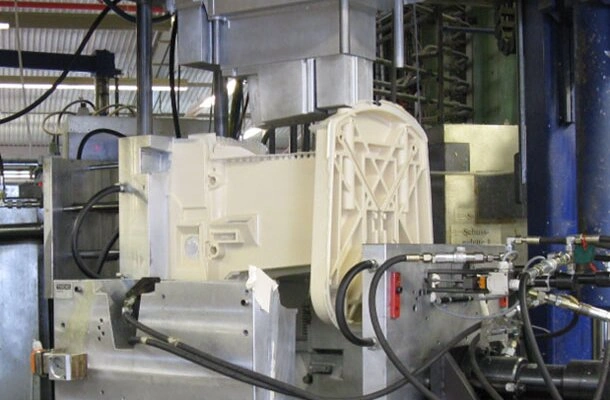
Reaction injection molding part
Firstly, the RIM molding process involves two or more reactive liquid materials, whereas standard injection molding involves injecting materials in molten form without any mixing or similar mechanism. Secondly, polymerization can create a closed-cell foam structure item with unique properties. Thirdly, the injection pressure for injection molding can go up to 100MPa. Meanwhile, the reaction injection molding pressure is not above 10 Mpa.
RIM Molding Process
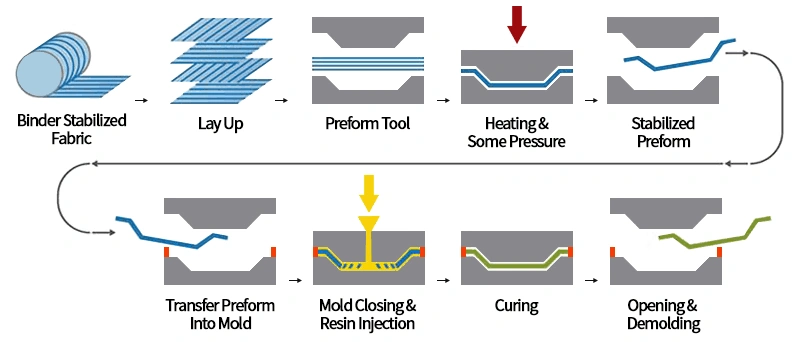
Steps of the RIM process
- Reactants Preparation
At first, liquid polymers (typically polyol and isocyanate) are separately stored in two tanks to avoid a premature reaction. The main concern in this step is maintaining the temperature and pressure of liquids inside tanks. Temperature fluctuations affect viscosity and, thus, the molding process.
- Homogenous Mixing
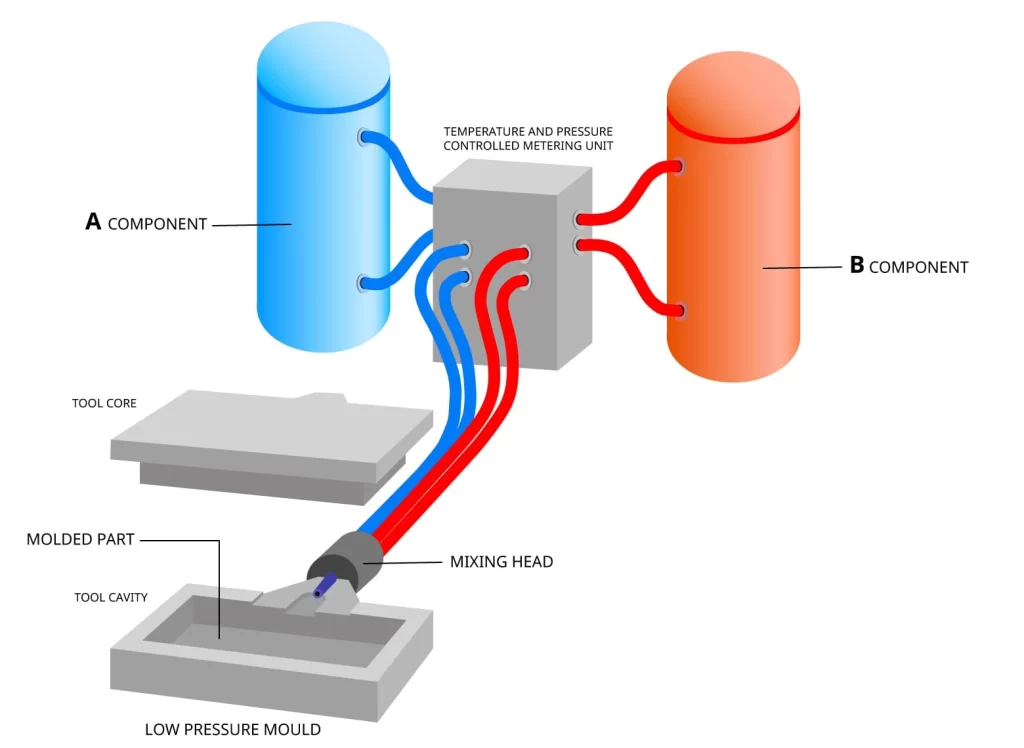
Mixing of material during RIM
The next step is preparing the homogenous mixture so the parts from each production cycle will be consistent. It involves pumping the liquids from both tanks into a high-pressure mixing head chamber. Additionally, a metering system exists attached to the chamber to maintain a determined ratio of two liquids.
- Injection and Polymerization
Next, the mixed reactants are injected into the mold cavity. Then, the mixture fills the entire mold and captures all the intricate details of the mold design. Meanwhile, the reactants undergo a chemical reaction inside a mold called the polymerization process. The polymerization causes the material to expand and solidify.
- Curing
The curing of the mold is critical to achieving full polymerization and the final properties. The curing time depends on the injection molding materials used and the desired characteristics of the final product. Advanced RIM systems use sensors and feedback loops to monitor the curing process in real-time, so the operator can adjust as necessary to maintain optimal conditions.
- Demolding
After the curing, the mold is opened and gently extracted using ejector pins or an automated system. Subsequently, the ejected parts go for post-processing like trimming, sanding, or polishing to achieve the desired tolerances and finish quality.
Reaction Injection Molding Materials
Primarily, RIM utilizes polyol and isocyanate mixture, known as Polyurethane. The excellent flexibility, impact resistance, and durability make it widely popular. Additionally, it can be formulated to be rigid or flexible. Other materials and their respective properties include;
- Epoxy Resins: Mechanical strength, excellent adhesion, and chemical resistance.
- Silicone Materials: Biocompatibility, heat resistance, and flexibility.
- Polyurea: Fast curing times with high resistance to abrasion and chemicals.
- Nylon: High tensile strength, excellent wear resistance, and good chemical stability.
- Composites: Reinforcing materials such as glass or carbon fibers for strength and stiffness.
Try Prolean Now!
Reaction Injection Molding Applications
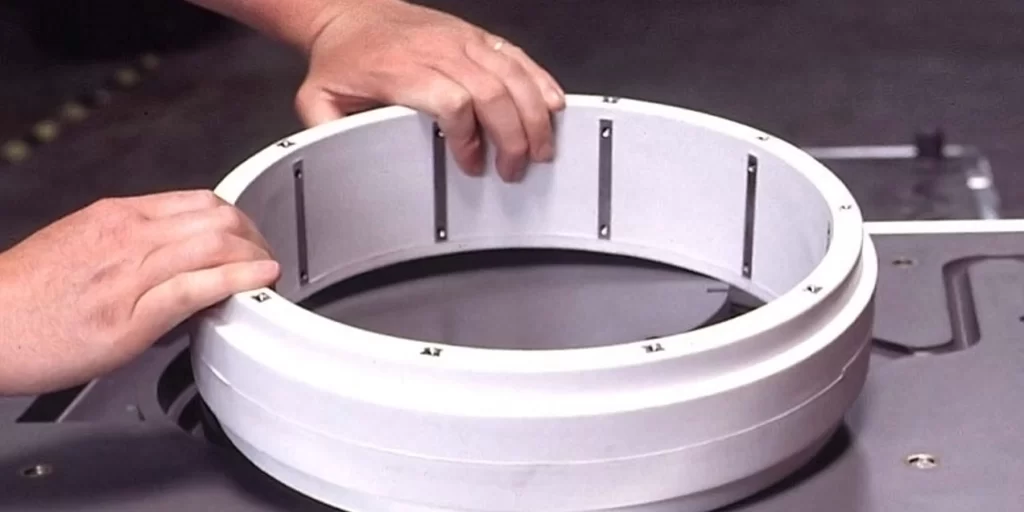
RIM application
The flexibility and end properties of reaction molding make it a prominent manufacturing technique across various areas, including automotive, industrial plants, aerospace, medical, consumer items, etc. Additionally, it also has the capability of molding thicker parts and parts with varied thicknesses.
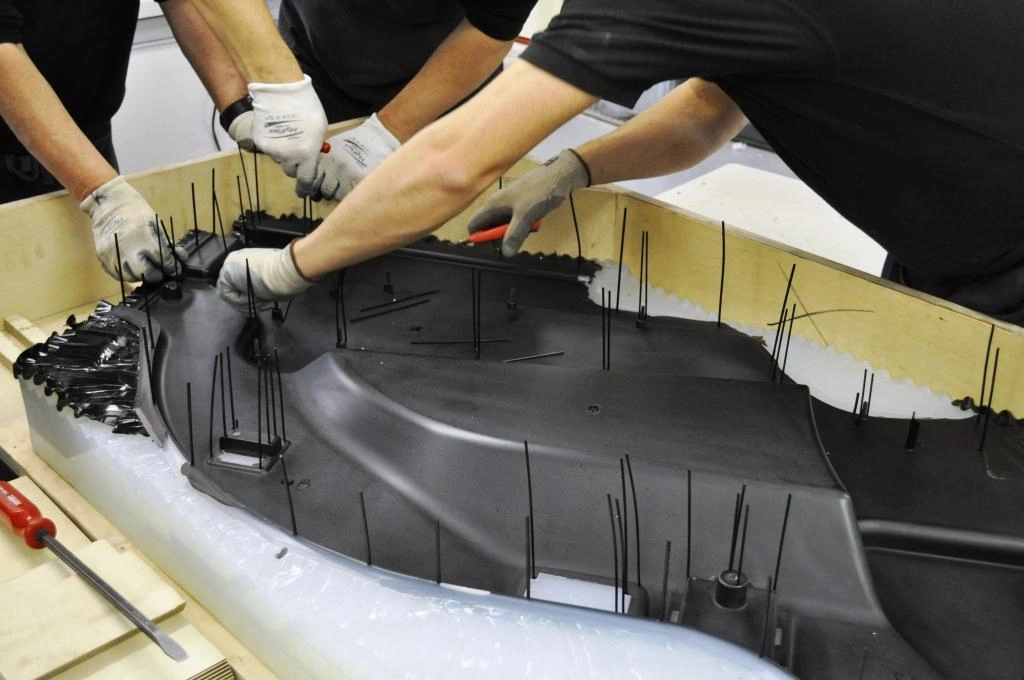
Reaction injection molding of large part
In the Automotive Injection Molding sector, the RIM molding process creates lightweight and durable components like bumpers and fenders, large parts with high-impact resistance. Similarly, it is used in Medical Injection Molding for biocompatible and durable parts with precise dimensions.
The below shows the application examples of reaction injection molding in main industries.
Table: RIM Molding Applications
|
Industry |
Applications |
|
Automotive |
Bumpers, fenders, door panels, dashboard components, base for seat, etc. |
|
Aerospace |
Aircraft furniture, interior panels, tray tables, etc. |
|
Medical |
Housing for diagnostic equipment, medical furniture, cart panels, etc. |
|
Electronics |
Cases and enclosures for many electronic items, camera bodies, etc. |
|
Industrial Equipments |
Tool handles, valve bodies, protective shields, housing for control panel, motor covers, etc. |
|
Spotting Goods |
Helmet shells, surfboard fins, kayak seats, padding, etc. |
Advantages of Reaction Injection Molding
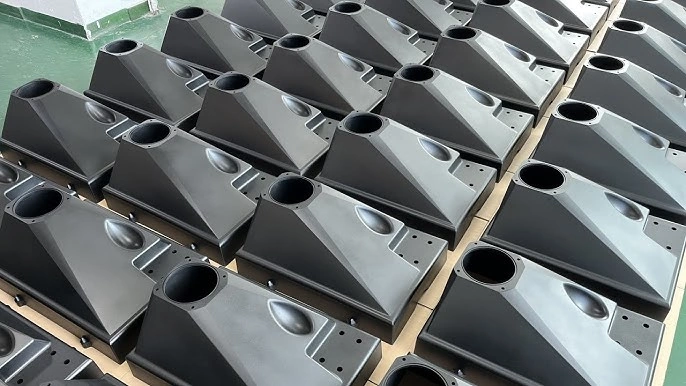
Smooth finish RIM plastic parts
- The process makes lightweight parts with excellent strnength and impact resistance compared to other plastic mouldings, or metal molding.
- Customization of final properties is possible by adding reinforcement fillers.
- The reaction molding allows for geometries with thickness variation.
- The low-thermal characteristics of reaction injection molding do not require expensive molds, typically custom aluminum moulds are used, which are cheaper than steel or other types of molds.
- The RIM molded parts are easily paintable and can achieve a high gloss finish.
- Any metal or other inserts can be added during the RIM molding process, allowing the various multi-material components.
Disadvantages of Reaction Injection Molding
- The material cost (polyol and isocyanate) is higher than other thermoplastics used in standard injection molding. As a result, the overall Injection Molding Cost can be increased.
- The material compatibility options are less for reaction injection molding only a few polymers can be reaction molded.
- The production cycle time is relatively longer than other plastic molding techniques.
Summing Up
Reaction injection molding is preferred over the standard process for large and thicker plastic parts. Its ability to foam the part during polymerization and customize the final properties with added re-enforcement fillers makes it indispensable in plastic parts manufacturing. However, a slight deviation and error in the mixing process or molding parameters can significantly affect the quality of the final result.
So, an appropriate ratio of mixing polymers and temperature and pressure controls are key to achieving quality RIM molding parts and products. ProleanTech has all the engineering expertise and advanced injection molding factory to meet your requirements and expectations. We mold 50+ materials regardless of which variation you want, RIM, Insert, Overmold, or any others. You can leverage Injection Molding Service for your business growth or research projects. Send us your design and request a quote, and we will get back to you!
FAQs
How is reaction injection molding different from standard injection molding?
Reaction injection molding (RIM) uses liquid reactants that chemically react and polymerize inside the mold to form a solid part. In contrast, standard injection molding melts thermoplastic pellets, injecting the molten material into a mold to form a solid part without any chemical reaction.
Are reaction molded parts durable?
Yes, reaction-molded parts are highly durable. They offer excellent strength, flexibility, impact resistance, and dimensional stability due to the cross-linked polymerization.
What materials can be used in RIM molding?
RIM molding primarily uses polyurethane( polyol and isocyanate mixture). Other materials include epoxy, silicone, and some composites.
What are examples of reaction injection molding products?
Some RIM molding products are automotive bumpers, aerospace interior panels, medical device housings, and consumer electronics enclosures.

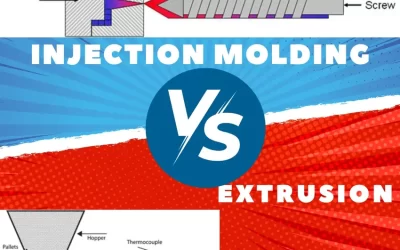
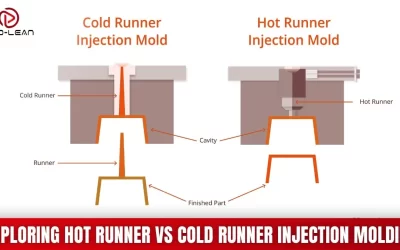
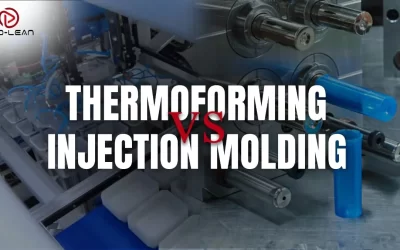
0 Comments